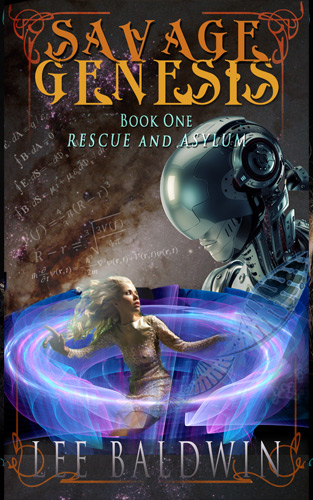Savage Genesis Book One ~ Rescue and Asylum
A Novel of First Contact
I LOVED this book… I wish all books were this original and well-written! I’ve read a LOT of ‘alien abduction’ literature over the decades (it’s just plain fun reading), so it was especially pleasing to see a different approach!
– Diane Donovan, Editor
Anna Lewis and Sally Jacobs are lifelong friends with careers in the physical sciences. When Sally abruptly disappears, Anna goes looking for her. But her misogynist professor has stolen her original work in computational archaeology and orders her to survey a dangerous borehole in Colombia, where a secret project searches for traces of alien presence on Earth.
This results in Anna taking a ride to a planet on the other side of the galaxy, where she meets humanity’s cousins. She struggles to understand that she and the other Earth women visiting there are part of a rescue project designed to save Earth’s people.
Feisty Anna is not the sort to simply accept what she is told, and the knowledge she finds among that ancient civilization is so overwhelming she must decide whether the societies of Earth will accept it, or simply kill her out of fear of The Other. Will she help, can she help, or will she die in the attempt?
Powerfully intimate and inventive, Lee Baldwin’s Savage Genesis ~ Rescue and Asylum is an unforgettable forward look into what we risk as human beings in the unthinking path we’re pursuing now. The novel highlights the cost of disloyalty to one another’s dreams, It’s a big idea story that uses the latest in scientific thinking about the nature of the universe as bedrock for carefully-wrought speculative fiction.
Savage Genesis ~ Rescue and Asylum, a Novel of first contact, is Baldwin’s fifth eBook on Amazon, KOBO, B&N and other seller sites. This is a novel of first human contact with an extrasolar intelligent species, which focuses on what humanity could become in the far future.
Click here to read the first 10% of the novel FREE.
The Premise of The Story
I found the premise for the story while thinking about the Drake equation, that product of strange-seeming terms that is supposed to estimate the number of intelligent civilizations in our galaxy. It struck me that this estimate is based on independent emergence, therefore the equation cannot predict the expansion of a single species to many planets. I wondered, what if life develops infrequently, but finds its own ways to expand across space? Those ways might include the rise to great intelligence, and methods of travel we’ve yet to imagine. In this vision, the Cuz Folk were born.
So, what if a spacefaring race did visit Earth in the deep past? Could they have influenced our biology and could we therefore be their genetic cousins? With these assumptions, the human race could be a relatively small twig of a hyper-evolved galactic civilization. I thought that situation interesting enough to form the premise of this book.
Deeper Background
Because of rapid star aging in the early universe, significant amounts of organic and metallic compounds necessary to biological life could have first blown across space in a timespan as short as three million years. The Milky Way galaxy where our planet spins in darkness is nearly as old as the current universe. This means that intelligent life could have appeared in our island universe 13 billion years ago.
What could such species be like today? Could they have progressed through a post-biological state of existence into a non-material one, and departed this universe to seek out a different physics? What if those beings control physics itself, through a hyper-evolved consciousness?
And can there be some structure or dimension along which unnumbered universes coexist, separated by the smallest quanta of distance? And what if there are spatial dimensions our philosophies never guess at, occupied by living beings? Suppose such civilizations exist across multiple dimensions of time and space and are aware of us, yet conceal themselves from even our imagination.
There are many other questions from my reading of physicist and cosmologist Paul Davies, theoretical physicist Beatriz Gato-Rivera, physicists Alan Guth and Brian Greene, and spiritual cosmologists Rupert Sheldrake, Deepak Chopra, Roger Penrose and others. Their inquiries have included theoretical physics, cosmology, astrobiology, quantum field theory, mysticism, the nature of consciousness, and the origins of life as we realize it.
Paul Davies demonstrates a key skill in asking the right questions. Two of his books, The Eerie Silence (2010) and The 5th Miracle (2000) were instrumental in leading me to a deeper understanding of how the universe could work. Davies’ clear scientific reasoning and insightful questions helped me elaborate the search that Anna Lewis undertook in this novel, and the bedrock of what she found.


